#Free speech handbook
Explore tagged Tumblr posts
Text
by Seth Mandel
The biggest myth regarding the campus anti-Semitism crisis is that it’s about speech. It is a self-serving myth: Institutions and activists that want to disregard their abuse of Jewish students will fall back on the claim that any attempt to hold them accountable for their actions is actually an attack on free speech.
Columbia University is learning what happens when that disingenuous trick starts to backfire: Students and professors take it as a license to do whatever they want, people end up in the hospital, and the government steps in to say this cannot continue to be done on their dime.
The Biden administration was fearful of standing up to the Hamas youth groups on campus. The Trump administration is happy to do so. Thus we have the announcement that three government agencies—Health and Human Services, the Department of Education, and the General Services Administration—will be reviewing federal contracts and grants with Columbia totaling around $5 billion.
Crucially, the announcement clearly avoids the penalizing of mere speech:
“Americans have watched in horror for more than a year now, as Jewish students have been assaulted and harassed on elite university campuses,” Education Secretary Linda McMahon said in a statement. “Unlawful encampments and demonstrations have completely paralyzed day-to-day campus operations, depriving Jewish students of learning opportunities to which they are entitled. Institutions that receive federal funds have a responsibility to protect all students from discrimination. Columbia’s apparent failure to uphold their end of this basic agreement raises very serious questions about the institution’s fitness to continue doing business with the United States government.”
Assault isn’t speech. Harassment, the definitions of which are laid out in these schools’ policy handbooks, doesn’t include “criticism of Israeli government policy,” as activists and well-meaning but foolish free-speech groups routinely claim. At Harvard, for example, “such aggression must be sufficiently severe or pervasive, and objectively offensive, that it creates a work, educational, or living environment that a reasonable person would consider intimidating, hostile, or abusive and denies the individual an equal opportunity to participate in the benefits of the workplace or the institution’s programs and activities. Unless sufficiently severe or pervasive, a single act typically would not constitute bullying.”
Last, discrimination is also not speech. I wrote about one such prominent example last week: George Washington University’s professional psychology program penalized Jewish students for their religious background and Israeli students on the basis of their national origin, a textbook Title VI civil-rights violation.
28 notes
·
View notes
Text
The New D&D 5.5 Rogue
For people who got an advance copy of the 2024 PHB, the NDA was lifted on August 1st. This is a summary from RPG Bot's 2024 DnD 5e Transition Guide and Change Log: Everything That’s Different in the new Player’s Handbook. See also here for more commentary on previously released details. I would like to note that:
The new Weapon Mastery rules (from the playtests) give martials lovely options they didn't have before.
There are some iffy flat DCs all over the book: the actions Hide (stealth), Influence (social skills), and Thieves' Tools (to disarm traps and pick locks) are all a flat DC 15. So this is either a completely stupid change (not all locks or all Persuasion checks were made equal!), OR the DMG will include rules and guidelines to adjust these DCs for different conditions.
Which (if that's the case) would mean that now Players and DMs know different rules about fundamental aspects of the game. I hate this, I hate that skills are now even less well-defined in the PHB, and I will rant more about this at a later time.
But anyway, here's RPGBot's summary:

Rogue
1. Expertise. No longer allows you to select Thieves’ Tools.
1. Thieves’ Cant. Also grants you an extra language proficiency.
1. Weapon Mastery. New.
3. Steady Aim. Identical to the Optional Class Feature.
5. Cunning Strike. Allows you to reduce your Sneak Attack damage in exchange for powerful rider effects like knocking the target prone or applying the Poisoned condition.
7. Reliable Talent. Moved from 11th level.
11. Improved Cunning Strike. New. Use up to 2 Cunning Strike effects on the same attack.
14. Blindsense. Gone.
14. Devious Strikes. New. Adds more Cunning Strike options.
15. Slippery Mind. Now adds proficiency in both Wisdom and Charisma saves instead of just Wisdom.
20. Stroke of Luck. Turn any d20 test into a 20. This means at least one guaranteed critical hit between each rest.
Arcane Trickster
3. Spellcasting. Now allows you to retrain a cantrip when you gain a level.
3. Mage Hand Legerdemain. Most of the 2014 feature’s capabilities were added to Mage Hand, with the exception of the ability to use Sleight of Hand and Thieves’ Tools. Now you can use Mage Hand for Sleight of Hand.
9. Magical Ambush. Now requires you to have the Invisible condition, which at a glance sounds like a huge problem, but the 2024 Hide action gives you the Invisible condition if you successfully hide.
13. Versatile Trickster. Now allows you to trip a target with your Mage Hand, but only when you use the Trip option from Cunning Strike.
Assassin
Much more reliable and less focus on disguises and infiltration. Much more stabby.
3. Assassinate. Reworked completely. Now much easier to use and much more consistently effective, but there’s no automatic critical hits.
3. Assassin’s Tools. Renamed from “Bonus Proficiencies”. Now also gives you one of each kit for free.
9. Infiltration Expertise. Reworked completely. No more false identity. Now you can perfectly mimic speech and handwriting, and Steady Aim doesn’t reduce your speed to 0.
13. Imposter. Gone.
13. Envenom Weapons. Extra poison damage when you use the Poison option of Cunning Strike. The damage applies whenever the target fails the save, which includes the additional saves at the end of each of their turns.
Soulknife
Very few changes.
3. Psionic Power. Like the Psi Warrior, the Soulknife’s Psionic Power feature now explicitly states that these dice are only for Soulknife features, the progression is tied to your Rogue level rather than your Proficiency Bonus, and you regain one die on a Short Rest.
3. Psychic Blades. The blades have the Vex Weapon Mastery, and can now be used for Opportunity Attacks.
Thief
3. Fast Hands.
Sleight of Hand. The wording here is a mess, but the Thief Rogue and only the Thief Rogue can use Sleight of Hand in conjunction with Thieves’ Tools to pick locks and disarm traps.
Now allows you to use magic items which normally take an Action to activate due to the new “Utilize” action. Existing item use case remain awesome.
3. Second-Story Work. Now much simpler, but functionally similar. A Climb speed and you use Dexterity for Athletics checks to jump.
9. Supreme Sneak. Reworked completely. Now a Cunning Strike option that allows you to attack without giving away your position.
13. Use Magic Device. Reworked completely. You no longer ignore restrictions on items, such as class requirements. Instead, you get an extra attunement slot, you have a chance to not spend charges when using a magic item, and you can use spell scrolls.
Picking Locks, Disarming Traps, Thieves' Tools, Sleight of Hand
Take a deep breath, because this one is confusing.
In the 2014 rules, you used proficiency in Thieves' Tools to disarm traps and pick locks. Sleight of Hand was used almost exclusively for picking pockets. Baldur's Gate 3 changed that when adapting the 5e rules for a video game.
In the 2024 rules, there is some confusion. Page 221 of the Player's Handbook details tools and their uses. Thieves' Tools list "Pick a Lock' and "Disarm a Trap" as two uses for the tool, which means that you apply proficiency with Thieves' Tools when performing those actions. This is the same as the 2014 rules.
The confusion sneaks in with the Thief Rogue's Fast Hands feature's Sleight of Hand option.
"Make a Dexterity (Sleight of Hand) check to pick a lock or disarm a trap with Thieves' Tools or to pick a pocket"
The lack of commas or formatting makes this text somewhat confusing. If it was intended to be three bullets, there would be commas. "Pick a lock comma disarm a trap with Thieves' Tools comma or pick a pocket". Instead, we can split your options with Fast Hands (Sleight of Hand) into two bullet points to clarify it:
Make a Dexterity (Sleight of Hand) check to pick a lock or disarm a trap with Thieves' Tools
Pick a pocket
This means that the Thief Rogue and only the Thief Rogue can use Sleight of Hand to pick locks and disarm traps while using Thieve's Tools. In fact, to do this as a Bonus Action, they're required to use Sleight of Hand. As per the rules for tools on Page 220 of the Player's Handbook, if you're also proficient with Thieves' Tools, you get Advantage on this check. All fantastic for the Thief Rogue and their ability to pick locks and disarm traps, especially since you can no longer get Expertise with tools, but you can get Expertise with Sleight of Hand.
If you are not a Thief Rogue, nothing has changed. Thieves' Tools are used for picking locks and disarming traps.
[source]
57 notes
·
View notes
Text
Thoughts on the "Updated" Bendy Employee Handbook
Before we go any further, let's make it very clear what kind of post this is: we're not here to hate on the book, and none of anything I'm about to say is said with ill intent. I am here for analysis, constructive criticism, and discussion. This post is a little more critical than what I would usually share, so viewer discretion is advised.
Today we're talking about the newly updated Bendy Employee Handbook, which just recently released as of this month at the time of this post. And I have a lot of questions about this entry, and really, game guides as a whole in our modern gaming world. This book appeared to advertise itself as a rerelease of the original handbook with additional content for Bendy and the Dark Revival, but upon comparing the two, I've noticed there's actually a number of changes they've made, some good, some bad, and some that I'm not sure what to make of. So come and join me under the cut, and if you have some thoughts of your own, feel free to comment or reblog and add to the discussion. Without further ado, here we go!
Part 1: The Baffling Amount of Cut Content
Our story begins where most stories do, the table of contents. So right off the bat, when comparing this book to the original, you'll notice something off.
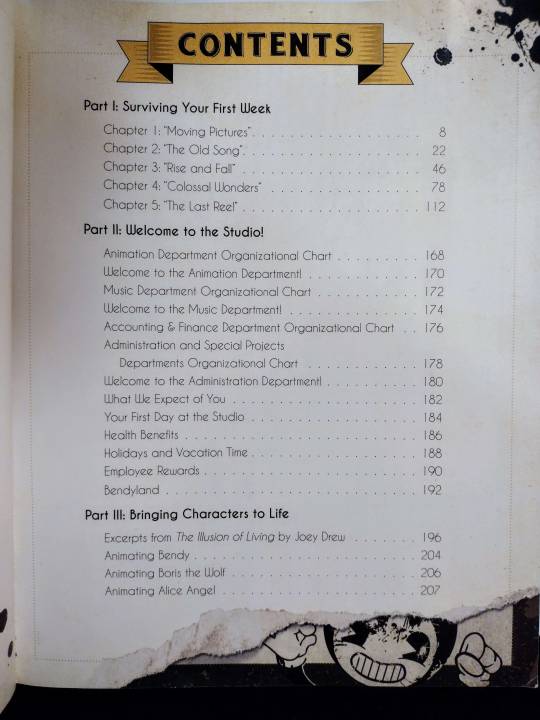
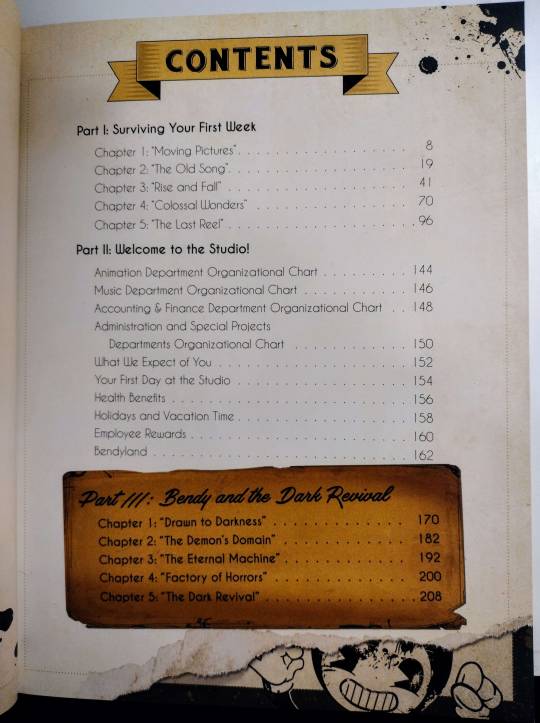
No, your eyes do not deceive you, an entire section of the original book was cut, on top of making other sections shorter. And the weirdest part? Some of these things were exclusive to that original book, they didn't appear anywhere else in the Bendy franchise. So already we're off to a weird start. Some of these missing pages aren't so bad though. In some cases, they're just format changes to make the book flow a little better/take up less room. Sometimes they succeed in that, sometimes they end up feeling more cramped, it's pretty subjective whether or not this improved the book. But it certainly does cut down on pages. Case in point, the beginning of each chapter of BATIM.
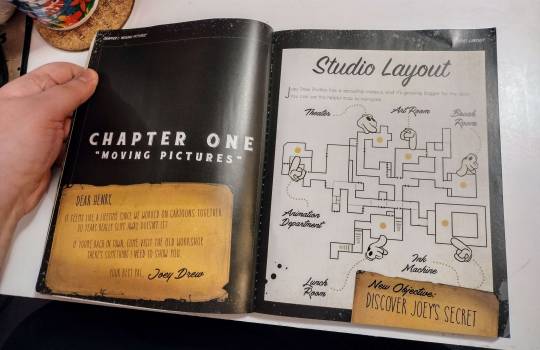
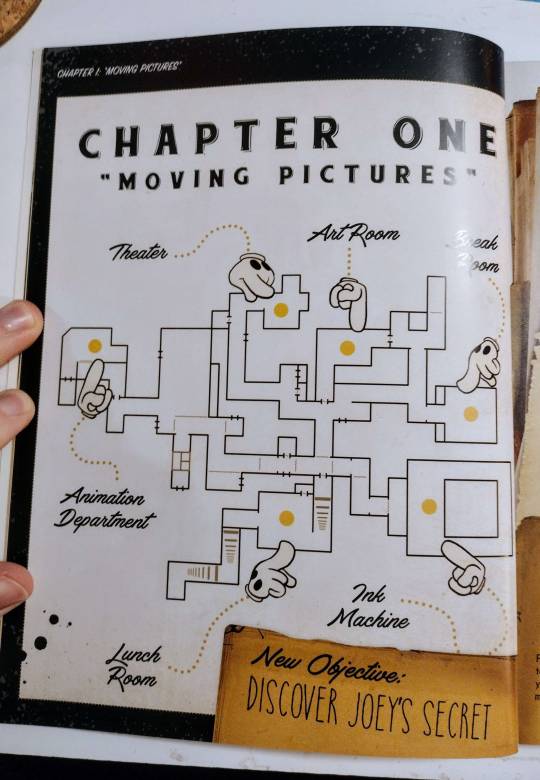
Don't worry, Joey's letter hasn't been cut, but it has been moved to earlier in the book, so it's no longer in Chapter 1. This was a very odd change. Other things that are missing are character monologues, but it's inconsistent. Alice Angel's speech about the screaming well of voices and Joey's monologue right before the final boss were kept, but Sammy's "sheep sheep sheep" speech and Bertrum's audiolog right before his boss fight were inexplicably cut.
Here are a few cuts I found pretty significant.



These pages are all missing from the update. In the case of this newspaper article, what does that mean in regards to whether or not this is "canon" or "retconned"? Joey Drew, did you or did you not have plans to expand into a Bendy themed toothpaste? The people need to know! X''D But seriously, while some of this is inconsequential, some of it matters. The mascot costume in particular, that's the only sketch we get (that I'm assuming came from Bertrum or Joey regarding that part of the parks, no one is specifically credited for making it). It doesn't show up anywhere else in the series (to my knowledge). It's strange that it's just, gone now. The Bendyland spread is such an unfortunate loss, that's some of the closest we've ever gotten to seeing the map of the park. Yes you can see it in BATIM, but being able to get up close and personal with it without having to control Henry was really nice. It makes me wonder if they're trying to erase the past details so they can do more with Bendyland in the future, something that's different from the original vision. I don't think that's it, but it could be, though they'd also have to go back on The Illusion of Living too, given it’s discussed there with some really fun details.
Speaking of which, that's the weirdest piece of cut content: the missing section that ends the old book (that was reiterated in The Illusion of Living). It's Joey Drew's tips for making a cartoon. It's formatted differently and has no images in TIOL, but the basic information is still the same. What's not the same though, is the loss of the tutorial pages for drawing the toons. These are another thing that don’t show up anywhere else in the series, making them a much more permanent loss. And even though this section is cut, it’s still referenced on the back cover of the new book, which is a bit odd.

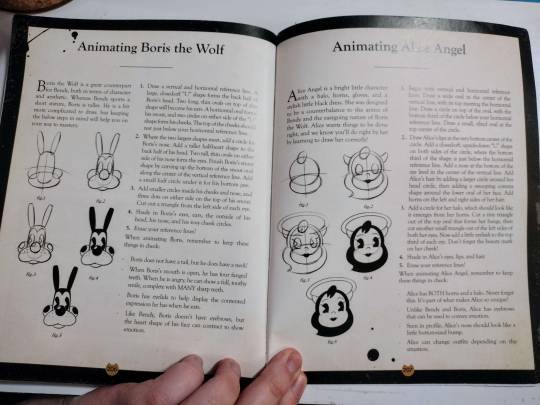
These were really cute and showed so much personality for not just the toons, but for Joey as he described them. Cutting this was genuinely disappointing for me. Same with the paperwork in Joey's apartment. Those were some of the highest quality images we had of what was on his desk and bulletin board, and I liked being able to see them clearer. The biggest loss of the cut content isn’t just the pages themselves, but the personality they gave to this book, and the Bendy world as a whole.
This was the very first Bendy book to be released, and therefore our first look into this world in this format. And while I don’t think it’s the greatest thing in the world in terms of being a game guide, I didn’t pick up the original for a game guide. I picked it up because I wanted to see if it provided more context for the world. And when it does that, it does a good job. The memos from characters we know, Joey’s financial records, the images from the desks of people like Joey and Bertrum, they give us insight into how things were going at the studio. Some of my favorite details from the original are Joey’s memo about how Susie was replaced by Allison, and the receipt for Joe’s Fine Dining. The fact that that memo was distributed to everyone but Susie enhanced what we already knew from BATIM, and it paints him as a much crueler character than we knew him to be. Not to mention the repeated use of “I have to say, I’m an instant fan”. Having Joey say those words makes the concept of him creating the cycle so much more interesting. Like did he script out every little action these characters take? Or is this something Susie picked up and recycled from him after potentially finding this memo in real life? Oh there are so many delicious possibilities. And the lunch date, oh my gosh. One, it started my quest to build the Joey Drew menu using all the things he eats in the books, because damn does he have good taste. And two, it was so cool to have a look into an interaction Susie told us about in that one tape. Like that was REALLY GOOD. Give me more like that! When you have other parts of the series back up things we’ve heard only one character say, it gives more credence to the idea that they actually happened that way, or gives us a clue that we need to check for character biases when they tell us their side of the story. And in a series where MOST characters are unreliable narrators, that is REALLY IMPORTANT for establishing timelines and figuring out what’s real versus what’s fabricated. That was my biggest hope for the update, for more flavortext and world building that expands on things we already know.
But um…the dark revival part of the book doesn’t do that.
Part 2: The Dark Revival’s Minimal Offerings
After an abrupt jump from Bendyland to BATDR, we get into the new stuff. The Bendy and the Dark Revival section of this book is alarmingly short and has very little substance. There is no new expansion of the worldbuilding or insight into these characters. I mean, the book describes Heidi as being a female lost one? So if you wanted a confirmation on her gender, there you go I guess? I guess that detail was never like, stated explicitly, but this is me stretching to find something new that it gives us. Actually, wait, it does give us one new thing, but I’m gonna be honest, it kind of rubbed me the wrong way.
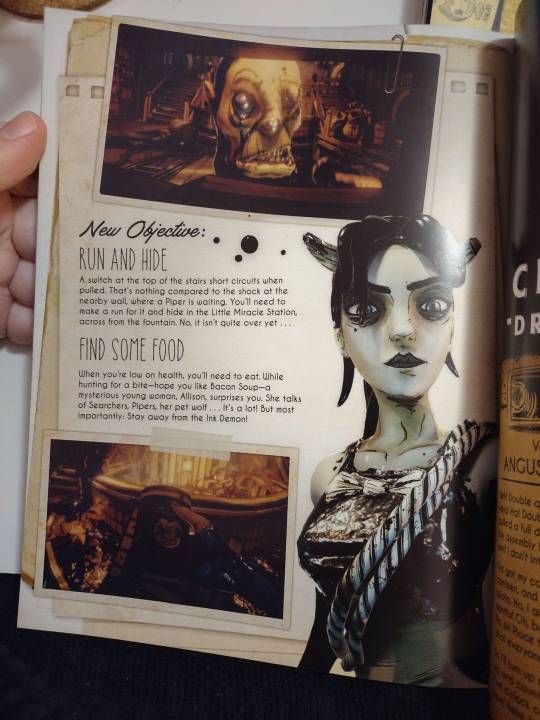
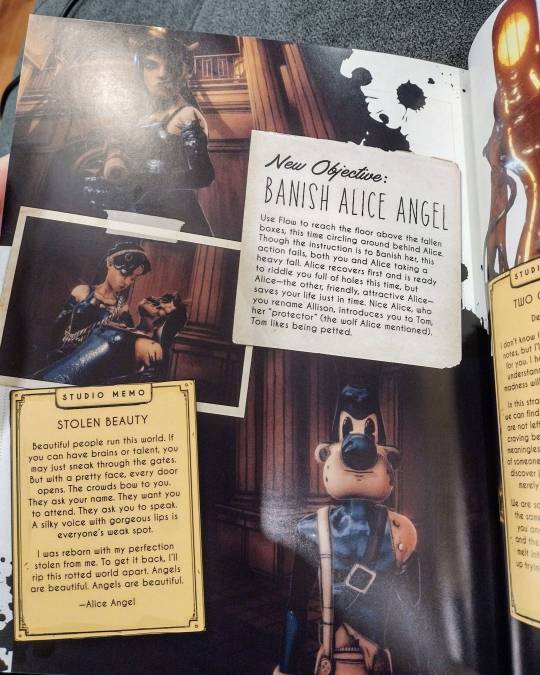
The book refers to Allison having a “pet wolf” when we get her introduction in Chapter 1. It then later describes that Tom “likes being pet” when we get his introduction in Chapter 5. Which by the way, is the only image of Tom in this entire book, since his original render from the old version was cut. Now, I’ll be honest, I used to like that second detail, I thought it was cute that he doesn’t just tolerate Audrey, he actually LIKES being pet. Those are two different things, having some insights into Tom’s feelings and characterization would have been a breath of fresh air. But no, when I reread the book and saw that first detail, that made that really weird and uncomfortable actually. It would be one thing if in-universe, Tom called himself a pet, or Allison called him that with consent. Heck, if there was another character in-universe who wanted to purposely insult Allison and Tom by saying that, that would be fine too, then it’d be reiterating the narrative. But on its own? I take issue with taking Tom of all characters and calling him her pet. The Safehouse Boris never got treated that badly, hell, Buddy in the books never got dehumanized this badly when he became a Boris. But Tom, Tom gets to be the one that’s dehumanized? There is something that really rubs me the wrong way about that. Especially if he turns out to be Thomas Connor or has some connection to him. I can’t assume if he is or isn’t anymore given all the stuff BATDR pulled with Allison and Henry. But on the chance he IS Thomas Connor, do you have any idea how bad that looks, to have a character that, because of details written in Dreams Come to Life, many fans speculate to be a person of color, referring to him as Allison’s “pet”? And even if he ends up not being a person of color (I say as I groan about the inevitable discourse for the DCTL graphic novel that’s coming out), it’s still kind of awful to say that about anyone. Tom is a character that has repeatedly gotten the short end of the stick in this series. He’s relevant to BATDR for all of a couple of minutes, and he’s incredibly underutilized and lacking details or depth for most of the series. Thomas Connor, he gets a bit of depth as of The Lost Ones, that novel does great things for him. But Tom Wolf? Short end of the stick. And I’m sad to see that continue here.
The one positive thing I have to say about this section is that it’s really nice to have so many of the audiolog character transcripts here. Most of the notes and logs from BATDR are here with all their words typed out. The ones that in-game had a chiller styled font are transcribed a bit strangely, as now they’re written like the messages written on the walls in-game. But it’s not the worst. If anything, all of this gives me a great resource as a theorist. Having a record of all of these and what chapters they appear in makes my goal of constructing a timeline and cross checking information much easier.
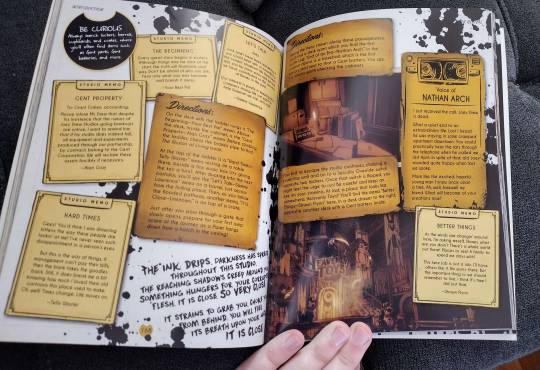

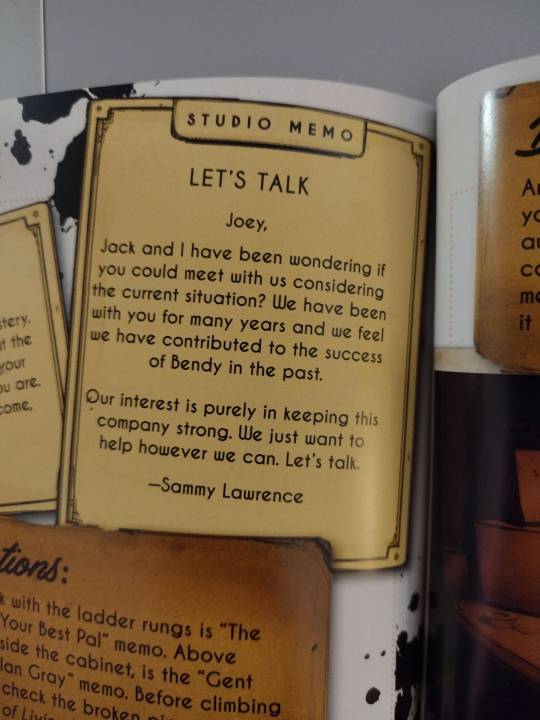
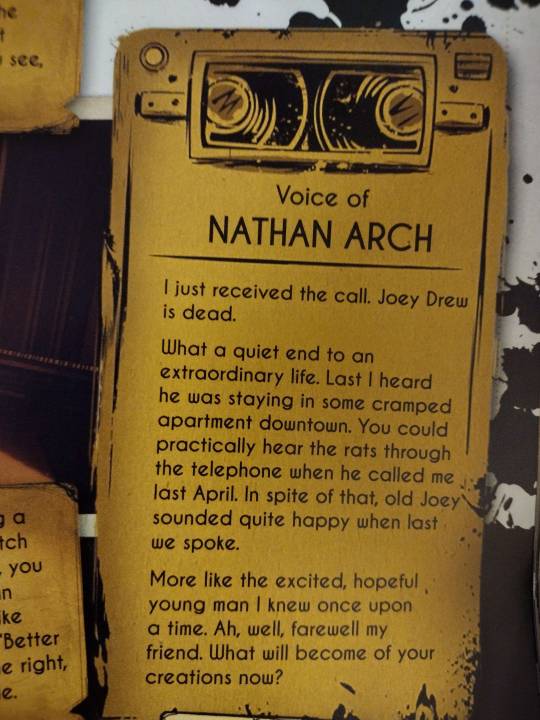
Though from a graphic design standpoint, these pages frustrate me a little bit. They’re so cramped, and there’s several spots where the text isn’t centered properly within its text block. I get the sense on some parts, it’s because it’s placed so close to the spine of the book, so they don’t want any information getting cut off, but it still looks funky. And there are several spots where that explanation doesn’t really apply. There’s also some weird placement of fun facts. While I love that this book lets us in on some secrets, they’re not always placed in an area that makes sense? Like, there’s a note about how to get the Inkjets Concert, but the steps for how to get it are placed way after a point in the narrative where you’d be able to get it, and I’m kind of scratching my head as to why it was done that way. Is it to encourage a second playthrough? Or is it to not spoil the story? Why not split the information up? Or have a dedicated secrets page like they do with the achievements and theMeatly’s cutouts?


Though speaking of not spoiling things, this book is really odd about what it chooses to focus on. So, Henry’s model is in this book, right next to a passage about a “mysterious man” you can meet in the Cyclebreakers area. They showed his model but didn’t name him as Henry? I don’t quite get that choice. Also, despite the cyclebreakers being very important to this story, they aren’t really mentioned before this very brief section. However, Porter? The character shown for all of a few seconds? He’s got at least three images throughout this book. The balance feels off with what this book chooses to put emphasis on.
Also, this one really annoyed me: Allison. So for everyone who’s actually played BATIM, you would know that Allison Angel is never referred to as Allison within BATIM. We only know she’s called that because people dove into the game’s files and revealed her and Tom’s names upon the release of Chapter 4. And the book follows suit with this, it does not call her Allison in the original handbook whatsoever. HOWEVER, the BATDR section messes this up. When it introduces her, even though in-game she introduces herself as Alice, the book introduces her as Allison. But when we get to Chapter 5, the part where she’s actually named Allison by Audrey, it suddenly switches to calling her Nice Alice? It’s a weird choice and I don’t understand why this happened.
It leaves me wondering just how much the new author of this section and their editors know about the Bendy series before going into this project. What context were they given to write this thing? It makes the book feel unpolished to have so many mistakes in its formatting and information. I don’t know what the quality control team for this release looked like, but a part of me wonders how many editors this went through before making it to the final release. I don’t work in publishing to know what that looks like, but I’d genuinely love to learn more on this subject, it’s fascinating.
There’s also a very strong dissonance in the imagery. While I’m glad to see the renders from BATDR’s advertising so clearly and up close, the difference in their coloring looks strange when put next to the rest of Bendy’s usual color palette. It leaves me wondering what assets the book team was given for use in this release. There’s a lot I could say here about the importance of press kits and brand guidelines, especially in this day and age when so many fans are making just as high quality of content as the official releases of media. And that leads me to the most disappointing part of this book.
Part 3: Stolen Content
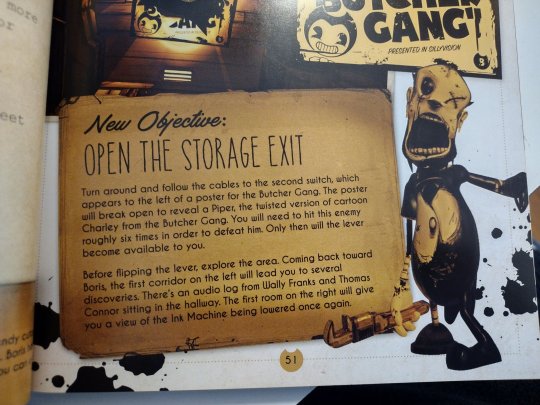
If you’re active in the Bendy fandom and know its many creative members, then you may already know what I’m about to dive into. MLSpence3D is an artist that enjoys 3D modeling, rigging, animating, and rendering. He can often be found engaging in all sorts of corners in the indie mascot horror community, such as playing a notable role in the production of SuperHorrorBro’s upcoming title, Glitched Out, as well as providing the renders used on the Bendy Wiki of the in-game characters. Spence has had his work mistaken for official renders before, and unfortunately, it’s not just fans making that mistake. The render of the Piper used in the BATIM portion of the original handbook is Spence’s, and it unfortunately hasn’t been removed in this update, nor has he been credited or asked for permission to have it used here. I’ll admit, his stuff looks so official that I’ve mistaken it as such too, and it speaks to a much needed conversation on assets, metadata, and protection for artists of all mediums.
Our fandom is not the only place where this happens. Back when FNAF: Help Wanted was in production, the cover art mistakenly used fan renders as a part of its photomanipulation. Developer Scott Cawthon was quick to apologize and make things right, removing the renders and replacing them with officially made FNAF models. Heck, we had something similar happen right here with Bendy back when the voice cast of BATDR started working with Streamily. The initial post that advertised their Streamily debut used renders from Spence and a few other artists that had to be tracked down, and they didn’t have the rights to use them, nor were they credited. It makes a lot of sense that this happens, when you don’t have sufficient resources and aren’t an active member of the fandom, if you’re a graphic designer trying to make a piece to advertise something, you’re going to need assets to make that. And if you’re not given sufficient assets by the people you’re designing for, you turn to other sources to get the job done. They may not know what on Google is official vs fan content. The fans are so skilled and passionate about what they do, and with the number of series that have fans steadily joining the official teams, it’s incredible what can result from being passionate. But it also makes for a much needed reminder to add metadata to your files so that they can be traced back as belonging to you. Watermark your stuff, clearly mark your work as fan content in the tags, captions, and descriptions, in an effort to protect yourself. Don’t use images you find online unless you have a very clear idea of where they came from, so you can direct people back to the source when they ask about it (or better yet, link the source in your description from the start). Give people another reason to pause and double check their work in the chain of command (they should be pausing to double check anyway, but let's be real, we don't live in a perfect world). In a world where credit and sources are more important than ever, remembering to give credit where it’s due from the start will save you all kinds of headaches in the future. Video game developers, especially those of you in the indie scene: please develop press kits to give to people your teams collaborate with. By giving them assets they can reliably use to advertise for you, you will save everyone a lot of hassle in the long run. And if this is still happening even with a press kit, it merits having some conversations to evaluate why and solve the problem. If there is no other takeaway anyone gets from this post, this is the big one I want to see some positive change on in the future.
Part 4: The Functionality as a Game Guide
This book works for your first time through BATDR, but not for any kind of sequential playthroughs. The way it directs you through the game uses the audiologs and notes as waypoints. Once you pick them up, they are removed from the environment, and so if you’re picking up the game after a long time away from it, you’re not gonna remember where those were, so it’s likely not going to be useful for navigating. It reminds me a lot of the way my parents talked about one of our old hometowns. We lived in Vermont for a little while, and there were two things about our area that we laughed about. One, never leave your car unlocked unless you want it filled with zucchini. Two, if you ask for directions, you’re not gonna have a clue unless you’re a local, because they word everything in a similar fashion to “you’re gonna drive past where the old barn used to be”. At least give me a landmark that still exists, or a map! The BATIM chapters aren’t much better, they sort of give you a layout map, but it’s not helpful. Especially in Chapter 3, the place where you arguably need a map the most, there is no kind of instruction for how to get through Alice’s fetch quests if you get lost.
In my mind, a game guide is something you turn to when you need help getting through a game. Now, mind you, I am not the target audience for a game guide. I don’t own game guides. There are a few in my household that my siblings own, for stuff like Super Mario Sunshine, and I guess technically my Pokedex for Pokemon Black and White 2 DOES double as a game guide. But like, we now live in the age of the internet. If you want to know how to get through something, there are a million articles and Let’s Plays that detail how to complete the base story, find secrets, and even suggest strategies for tackling difficult challenges. Some of these are designed to be informative, and some are more reactionary and built for entertainment, there’s lots of flavors to choose from!
And it makes me wonder, what does that mean for the medium of game guides as a whole? I think they still have their place. For one thing, different people benefit from different learning styles. Being able to read a guide may work better for someone than a video depending on their brain wiring. And for people who don’t have reliable or frankly any internet, or rely on a library for that, it’s nice to have a book so that you don’t have to wait to keep playing. I’ve never seen anyone get a game guide from a library, but I absolutely think it’s something a library could have. It’s also just really convenient to have all of that information available in one book, as opposed to having to search through multiple forums and sources and risk getting spoiled. And when they’re done well, sometimes they can have secrets not even the existing player base knew. Like I knew that there was this secret about a ghost train that appears if you set your system’s clock to 4:14, but I didn’t know if AM or PM mattered. Thanks to this book, now I know that it doesn’t matter, both work, which is really handy to know! But uh…most of the secrets that were revealed in this book were things I knew within the first month that BATDR came out. None of them were new to me as someone who’s plugged into the world of Bendy. There have been multiple videos detailing how to get these secrets, and how to play this game, by many different indie horror enthusiasts. It almost makes it feel like this book came out a bit too late, and it’s only released about a year or so after this game came out.
Which really begs the question, who was the target audience for this book? Was it for new fans who were struggling with these games? Was it for longtime fans who wanted a memento of the occasion and a record of all the stuff in these games? Was it for lore hunters hungry for new secrets and world building? Having read both versions of the employee handbook, I still can’t definitively say who the target audience is. That kind of frustrates me, that’s the first thing they taught us about back when I went to school for graphic design. It’s important to keep your audience in mind when designing something, that way it caters to their needs, appeals to them, and gets your message across effectively.
Part 5: Final Thoughts
I still can’t say for sure what I was supposed to get out of this.The parts of it that I found charming and appealing were not continued or built upon in this update. There is no new world building or lore. It doesn’t do an effective job as a game guide given its reliance on non-permanent elements of gameplay. It doesn’t give us tools to cross reference what we know from previous entries, nor does it expand upon details that lacked clarity within BATDR or BATIM. It removed some of its more charming content, and it still has stolen artwork from its previous iteration. By the time I got done reading this book, I was left feeling disappointed and kind of exhausted. No joke, I grabbed a friend, and we went through it all to compare it page by page to see what changed. It was something you could make a drinking game out of, not that I would recommend that.
I would struggle to recommend this book to any Bendy fan, unless you’re a completionist like me who wants to own every book as a physical copy. The original employee handbook was a far better read, and if you can find a copy secondhand or at your local library, you’re in for a small but tasty treat (quite literally if you decide to make the bacon soup recipe, which fun fact, originated in this book and was developed by the wife of Bookpast, one of the writers on this series!). The Dark Revival section feels tacked on and not as well thought out as the original book was. There is a very odd disconnect between the two. I’m genuinely confused as to why it was put in a rerelease of this book rather than making an entirely new book for Dark Revival. Dark Revival is a much longer and detailed game than Bendy and the Ink Machine. I would expect a book that describes how to play it and its world building to take up a lot more pages and go in depth on different details than this one did. So why was it done this way? Does this have to do with some sort of contract with Scholastic that we don’t know about? Was there a time constraint, or a page count that had to be met that they couldn’t meet with just BATDR? Did the people working on Bendy have too much on their plates to dedicate the time to a new book? What happened here? I wasn’t expecting to leave this book with more questions than answers, but here we are.
Overall, I don’t think it was worth what I paid for it, but it’s going to live on my shelf with the rest of my books. This will be handy for when I need to reference the audiologs and don’t want to look up a YouTube video to remember what was said. It’ll also be nice if I’m traveling. See, whenever I visit my grandparents, their wifi is pretty limited, so if I want to draw anything while I’m up there, I have to print out references or download images on my phone before I go so I can do that. Having some of the new renders in this book will be useful if I decide I want to draw Bendy stuff or theorize while on the road.
Now it's your turn. Tell me your thoughts on the Updated Edition of the Bendy Employee Handbook! Is this something you want to read? If you have read it, did you enjoy it? Were you left wanting more? If we ever get another book like this, what sort of things would you like to see? Let's talk about it. And remember, if you did enjoy it, that's not a bad thing, absolutely no judgement there. Just because it wasn't for me doesn't mean it's not going to be enjoyable for someone else. Every work of fiction has its audience. <3 Here's wishing you a wonderful rest of the day, and happy reading!
#bendy employee handbook spoilers#bendy employee handbook#bendy spoilers#batdr#bendy and the dark revival#batim#bendy and the ink machine#bendy books#bendy book spoilers
85 notes
·
View notes
Text
A series of links led me to this: Southern Poverty Law Center's article and list of anti-LGBTQ+ groups active in the United States, and their influence on legislation in this country and internationally, and the increasing anti-trans rhetoric, and action, purveyed by them.
SPLC pulls no punches when calling-out people and groups that promote hate in the name of anything else (parents' rights, Christianity, etc) and the same goes here. The list is accompanied by a map featuring how many anti-LGBTQ+ groups are active in each state.
Some highlights:
"In 2023, the number of anti-LGBTQ hate groups listed by SPLC increased by about one-third, to 86. This is the highest number of anti-LGBTQ groups SPLC has ever listed. The increase is largely the result of the activities by groups often described as 'family policy councils,' which operate at the state level in ways that mimic the national organizations Family Research Council and Alliance Defending Freedom...
...the weaponization of pseudoscience as a tool of trans suppression and the targeting of fundamental freedoms like free speech, expression, and assembly through book and drag bans has become a more prominent feature in recent years...
In April 2023, the Heritage Foundation published its 'Mandate for Leadership,' a 900-page handbook that lays out the implementation strategy of its presidential transition plan known as 'Project 2025.' The project represents a dramatic reshaping of the federal government by recruiting and vetting conservative ideologues for positions in a hypothetical 2025 Republican presidential administration. It also represents a dramatic confirmation of the anti-science and anti-LGBTQ focus of the contributors to the plan. Namely, on page 1 of the Mandate for Leadership, Kevin Roberts of the Heritage Foundation claims that 'children suffer the toxic normalization of transgenderism with drag queens and pornography invading their school libraries.' By page 5, Roberts claims, 'pornography' is 'manifested today in the omnipresent propagation of transgender ideology and sexualization of children' and argues that such manifestations be outlawed. Roberts also argues that 'the people who produce and distribute [such materials] should be imprisoned. Educators and public librarians who purvey it should be classed as registered sex offenders. And telecommunications and technology firms that facilitate its spread should be shuttered.'"
And of course it gets better. I didn't know, but am not surprised to read, that anti-trans rhetorical hate has now been morphed into a version of the "great replacement" conspiracy theory: children, including children of gay or lesbian couples, "...are being replaced or 'transed' against their will by gender-affirming health care and LGBTQ-inclusive educational curricula."
Fuck: anything to rile up people and get them to vote in autocracy.
Full story
#trans rights#lgbtq rights#human rights#anti-trans hate#southern poverty law center#project 2025#election 2024#vote blue#society#these united states
18 notes
·
View notes
Text
Shadows of the Force

PAIRING | Captain Rex x F!OC (Stella Cardone) WORD COUNT | 1.3k PREVIOUS CHAPTER TAGLIST | @cw80831
Chapter 6: Captain No-nonsense
Back on the cruiser after the mission, the clones invited me to join them in the mess hall. They'd grown comfortable enough to treat me like one of their own, and the easy banter between them was refreshing.
"So, how's it going with Captain No-Nonsense?" Jesse asked with a grin, as he spooned a mouthful of rations.
I raised an eyebrow. "Captain No-Nonsense?"
Fives laughed. "You heard him. Rex isn't exactly... chatty."
I smirked, glancing down at my food. "Well, he's thorough. And he keeps me out of trouble."
Echo chuckled, nudging Fives. "Yeah, that's Rex for you. Not one for small talk, but the first to have your back when things go sideways."
Kix raised a brow. "Bet he's already given you the classic Rex pep talk."
I shook my head, laughing. "No pep talk, but he did tell me my form needs work."
They groaned in unison, and Jesse laughed. "It's a miracle! He must actually like you if he's already bothered with the form speech."
Their laughter filled the mess hall, catching Rex's attention from across the room. I noticed him glance our way before returning to his datapad, his expression unreadable but somehow warmer than usual. Fives nudged me with a knowing grin.
"Careful, Stella," Fives teased, "Captain No-Nonsense's got a sharp eye for potential."
"Yeah," Jesse added with a grin, "but don't let it go to your head. Rex doesn't hand out compliments for free."
"Good to know" I said, glancing over my shoulder. "Though with him, potential probably just means I survived the mission without tripping over my own feet."
Fives chuckled, leaning back in his chair. "Well, surviving your first mission is a big step up from the shiny recruits we usually get. Most of them don't even make it through the first round without spraining something."
"Or falling flat on their face," Kix chimed in, giving me a wink. "Though I'm sure the Captain would say it a bit more... formally."
Echo grinned. "Oh yeah, he'd say something like, Coordination is crucial to mission success, trooper. Always makes it sound like he's about to draft a report."
I laughed, catching their contagious energy. "And I thought my training at the Jedi Temple was intense. Are you guys saying Rex has a whole handbook of these phrases?"
Echo nodded, taking a sip of his drink. "Oh, he's got a whole archive of them, believe me. We call it Rex-speak. After a while, you just get used to translating it."
Fives leaned in, lowering his voice conspiratorially. "You'll know he really likes you if he skips the Rex-speak altogether and gives you the simple version. Until then, brace yourself."
I shook my head, grinning. "Sounds like I've got a lot to learn."
Echo glanced over at Rex, who was still focused on his datapad, his brow furrowed. "He's like that with everyone he cares about, you know. Doesn't go easy on the people he wants to keep alive."
A pause settled over the table as they all looked down at their plates, a moment of quiet respect for their captain. Finally, Jesse broke the silence with a mischievous smile. "Still, if he starts calling you by your first name, that's when you know you've made it."
"Jesse, we all know that's a lie," Fives shot back. "Rex doesn't even call me by my name half the time."
Echo laughed. "Keep dreaming, Fives. Some of us might actually make it to first-name status someday."
Jesse grinned, turning back to me. "But you, Stella? You might be the exception. So, if you ever catch him saying more than three sentences to you at once, you'll know you're in."
I laughed, shaking my head. "Noted. Guess I'll keep my ears open for that three-sentence miracle."
After we wrapped up in the mess hall, I headed down to the hangar for a quick equipment check. The boys trailed after me, still joking around as they finished their rations. I spotted Rex already there, running a routine inspection over one of the gunships.
As I approached, he looked up, his expression as steady as ever but with that subtle focus he wore when things were about to get serious.
"Padawan Cardone," he started, nodding in acknowledgment. "You did well today. But remember to keep your focus on your surroundings; you were a little close to Jesse's line of fire back there. And watch your footing when you move in—staying low to the ground can help keep you out of sight."
My mouth opened, but I wasn't sure what to say. That had to be the longest set of sentences Rex had ever spoken to me.
The boys, who had stopped just behind me, went completely silent. Then, Fives muttered under his breath, "Did he just... say all that at once?"
Rex shot him a look, his jaw tightening as if he suddenly realized he'd broken his usual protocol. "Fives," he said in a firm voice, "I expect you to back me up on the next mission. The same goes for all of you."
Fives coughed, but the smirk in his eyes was unmistakable. "Yes, sir. Just... making a note of the record-length briefing, sir."
Jesse leaned over, whispering to me with a grin. "Looks like you got that miracle. The three-sentence threshold."
I gave him a nudge, trying to hide my own smile. "Looks like it. Guess he really does want to keep me alive."
Rex, pretending not to hear the whispers, only continued. "Stella, remember—potential's one thing, but discipline keeps you sharp. Keep up the focus, and you'll get there."
Kix raised a brow, muttering to Echo, "That's at least four sentences now. He must really mean it."
Rex exhaled sharply, looking over at them with raised eyebrows. "If you're done with commentary, maybe it's time you all ran through your own field reports."
"Yes, sir," they chorused, barely containing their laughter. They saluted with exaggerated formality, and then each of them gave me a quick thumbs-up as they left, smirking.
As they filed out, Rex looked at me, faintly amused despite himself. "They're good people, Stella. And so are you."
I nodded, feeling a little overwhelmed by the genuine, if subtle, approval in his voice. "Thanks, Captain."
He gave a small nod. "Get some rest. You'll need it."
As the rest of the squad left for the barracks, I lingered a little longer, watching Rex finalize the inspection of the gunship. My heart was still pounding, that mix of nerves and pride from his words still lingering.
"Something else you need?" Rex's voice was as steady as ever, but there was a faint glint in his eyes.
I hesitated. "I just... wanted to thank you. For looking out for me today."
He paused, giving me a slight nod. "It's my job. But you're adapting fast. I can't say that for every Padawan I've come across." His tone was low, as though he were sharing something just for me.
I smiled, feeling warmth at his words. "Coming from Captain No-Nonsense, I'll take that as a high compliment."
He raised an eyebrow, a hint of a smile pulling at the corner of his mouth. "Is that what they're calling me now?"
"Well..." I shrugged, biting back a grin. "Let's just say it's catching on. But, if it helps, I think they mean it in the best way."
Rex shook his head slightly, amused. "These boys never stop with the names" He glanced around the hangar, then added more quietly, "They trust you, Stella. That's a good sign."
With a final nod to Rex, I turned to head down the corridor, lost in thought—until Fives and Jesse doubled back to find me.
"Hey, Earthling!" Fives called, giving me a playful nudge. "You coming, or what?"
Jesse threw Rex a knowing look. "We're off to run some... routine maintenance drills. You're invited, Captain," he added, his tone light but clearly expecting Rex to stay behind.
Rex's lips twitched with amusement. "Think I'll pass. Just don't let those routine drills get you into trouble."
Fives shot him a wink. "No promises, sir."
As we walked down the corridor, Fives nudged me, eyebrows raised. "So... an actual conversation with the captain, huh?"
I chuckled. "Guess so."
Jesse glanced back with a smirk. "Better not get used to it. He'll probably be back to his usual yes and no by tomorrow."
We all burst into laughter, the sound echoing through the empty corridor, and for the first time, I felt like I truly belonged.
_____________________________________________________________
You can read the next chapter here and find my masterlist here x
#captain rex#captain rex x oc#swtcw#fanfic#tcw#501st#anakin skywalker#master yoda#arc trooper fives#jesse#clone medic kix#kix#echo#jedi#jedi oc#star wars oc#romance#slow burn#fives#arc trooper jesse#arc trooper echo#tcw fanfiction#star wars fanfiction#anakin x oc#anakin skywalker x oc#jesse x oc#arc trooper Jesse x oc#echo x oc#fives x oc
12 notes
·
View notes
Text
Jesus Mesa at Newsweek:
CBS News anchor Margaret Brennan has built a reputation as a sharp, unflinching interviewer who holds powerful figures accountable. But since President Donald Trump's return to the White House in January, she has also become a target of many MAGA supporters who see her as emblematic of everything they believe is wrong with the media landscape. Over the first month of the Trump presidency, Brennan, who currently serves the moderator of the venerated Sunday program "Face the Nation," has found herself in a place few journalists wish to be: at the center of the conversation—criticized, dismissed, and, in some cases, outright mocked by the president's loyalists.
Why It Matters
Brennan's most recent confrontation with a member of the Trump administration came during a heated exchange with Secretary of State Marco Rubio on Sunday. She pressed Rubio about Vice President JD Vance's appearance at the Munich Security Conference, in which Vance denounced censorship and met with the leader of a far-right German political party with, as Brennan put it, "some historic ties to extreme groups." When Brennan suggested that free speech had been "weaponized" by Nazi Germany "to conduct a genocide," Rubio quickly pushed back, calling it a misrepresentation of history and countering that the Holocaust was the work of an authoritarian regime that hated Jews and other minorities. "There was no free speech in Nazi Germany," Rubio said. The back-and-forth quickly went viral, placing Brennan in the spotlight and raising questions about her knowledge of history as well as what her critics said was an anti-Trump bias reflected across the mainstream media, which is now among the least-trusted institutions in the country. Vice President Vance himself even joined the fray, blasting Brennan on social media. "This is a crazy exchange," he wrote. "Does the media really think the Holocaust was caused by free speech?" The fiery moment became a rallying cry on conservative media, with outlets praising Rubio and Vance for "calling out" Brennan. It played directly into an ongoing narrative on the right — that mainstream journalists like Brennan aren't just biased but are actively pushing an agenda. Frank Sesno, a former CNN correspondent and director of George Washington University's School of Media and Public Affairs, saw Brennan's treatment as part of a broader trend where the media itself has become a battleground. "That's a play straight out of the modern political handbook: discredit the journalist, shift the focus, and make the media the story rather than the issue being discussed," Sesno told Newsweek.
[...]
There's Fatigue'
Brennan's clashes with Vance and Rubio have made her a frequent target in MAGA circles, something Sesno, the CNN veteran, called problematic but unsurprising. "This isn't just about Brennan or CBS. It's part of a broader trend where politicians treat the press not as a watchdog but as an adversary to be humiliated. And when that happens, the public loses," Sesno said. Amid its own business challenges, one question looms over the media landscape: will Trump's return reignite the "Trump bump" that once drove record ratings and traffic, or has the country moved on from the hair-on-fire coverage of his first term?
CBS’s Face The Nation host Margaret Brennan has become a punching bag by MAGA cultists, all because she is willing to confront them on their BS.
See Also:
Times Now World: Did Margaret Brennan Say Free Speech 'Caused' Holocaust? Fact-Checking Claim
Raw Story: 'Shame on Margaret Brennan': MAGA leaders melt down over CBS News journalist's interview
5 notes
·
View notes
Note
The m34th going through different witch seduction tactics, meanwhile Lime is just: thighs thighs thighs thighs
HE WOULD!!!!! also it would be VERY funny if the anti-witch-seduction (AWS) training had the exact same vibes as those free speech training things they make you do in university where you watch a bunch of bad acting videos and answer very easy questions that have very obvious correct answers if youre not a monster
lime having to sit there watching another video of someone dressed as a fake witch and then taking a multiple choice quiz thats like "You see a witch trying to bribe you with her body, do you A) bring her in anyway, or B) give in?" and hes like "Boy oh boy i wonder what the right answer is"
or its one of those cringey corporate team meeting vibes where everyone sits down in a big room and the manager goes "okay im not naming names but REMEMBER IN THE HANDBOOK how it says we're not supposed to sleep with witches?? yeah?? that was in the handbook guys. please read it again if you need to. this is not team player behavior"
#and EVERYONE is zoning out and mad at whoever got caught#as a psa lime is never the reason why these meetings get called#hes sneaky and smart about mochi#its some other idiot asshole having a love affair with the badger witch in the mountain region or some bullshit#the m34th is largely a very awesome and very cool and serious organization#but i need to throw in the dumb moments like this because i think its very funny#90% of the time they leave you alone with your missions and just ask that you report in and do your paperwork every now and again#and then theres the bureaucracy of government training programs hidden in the bowels of the org
29 notes
·
View notes
Text
The Modern-Day Witch Hunt
The label "far-right" today carries as much weight and destruction as the cry of "witch!" did in the Middle Ages.
No evidence needed, no investigation necessary just one accusation, and suddenly you're cast out, demonised, and ostracised. The term has become a catch-all, a convenient way to smear anyone who dares challenge the mainstream narrative. And I'm angry. I'm angry because this label isn't about protecting society from extremists it's about shutting people up, getting rid of the ones the powers that be don't like.
In the Middle Ages, women (and occasionally men) were labeled witches for everything from being a bit too independent to knowing how to use herbs. The accusations came without evidence, often based on hearsay, jealousy, or fear. The mob didn't care about facts. They cared about punishment. It was a tool for control, a way to silence the different, the non-conforming, the inconvenient.
Sound familiar?
Today, the new word hurled around with reckless abandon is "far-right." Disagree with the government? Far-right. Question mainstream media? Far-right. Express a thought that isn't perfectly in line with the social justice warrior handbook? Well, congratulations—you’re a Nazi now. There's no debate, no dialogue, no effort to understand why someone might hold a different view. Just an accusation. And just like the Middle Ages, it sticks. It sticks hard. The label isn't just a political designation anymore; it's a moral condemnation. The implication is that if you're "far-right," you’re evil.
You must be silenced.
And here’s the kicker—there’s no real definition of what "far-right" even means anymore. It’s nebulous, vague, and deliberately broad. They’ve weaponised the term so that it applies to anyone they want to get rid of. You can be fiscally conservative and socially moderate, but God forbid you utter the wrong opinion on immigration, gender, or healthcare. The second you step out of line, there it is you're branded. Once you're marked, you're banished from polite society, canceled, and pushed into the margins.
Just like a witch.
The hypocrisy of it all is staggering. The same people who claim to be champions of tolerance and free speech are the ones waving the torches, lighting the pyres, and throwing around the accusations. They preach about "inclusion," but only if you subscribe to their ideology. If not, you’re not just excluded you’re demonised. They don’t want discourse; they want conformity. They don't want dialogue; they want obedience.
The modern witch hunts are real, and they are vicious. It’s not enough to disagree with someone’s politics anymore—you have to destroy them, strip them of their humanity, and reduce them to a two-dimensional villain. It’s lazy, it’s cowardly, and it’s dangerous.
In the Middle Ages, they drowned, hanged, or burned the ones they called witches. Today, they do it differently, but the outcome is the same. They ruin careers, smear reputations, and incite mobs to tear down anyone who dares dissent. The tools may have changed, but the intent hasn’t: silence the inconvenient, punish the different, and maintain control.
I refuse to stand by and watch as this modern witch hunt tears our society apart. The next time someone throws around the label "far-right," ask them what they mean. Demand evidence. Don’t let them get away with vague, slanderous accusations. Because today, it's someone else being labeled. Tomorrow, it could be you.
And I’ll be damned if I stand in silence, watching another pyre being lit.
#Far-right#Modern witch hunts#Political labeling#Cancel culture#Free speech#Media bias#Mainstream narrative#Social justice hypocrisy#Political discourse#Mob mentality#Demonization#Conformity vs. dissent#Thought policing#Censorship#Freedom of expression#Ideological control#Witch trials#Public shaming#Political extremism#Weaponized accusations#today on tumblr#new blog
4 notes
·
View notes
Text
Blog post #6
How does the media shape the way people think about technology?
Media plays a huge part in shaping the public opinion. When discussing technology, media can often present it in a negative or a positive light. For example, In this class, we talk about how technology can usually have underlying issues such as racism, sexism, trolling, etc. Also, as I said the media shapes cultural narratives so whatever is trendy at that point in time is gonna be the main opinion for most people. So, the media has a very huge part in the opinions of the public.
What challenges do social media platforms face when moderating hate speech?
There are many challenges that social media platforms face when trying to moderate hate speech. The biggest issue would be that a person could just make another account and continue the cycle, but there’s also an argument that once there is moderation on a platform nothing will be allowed and that free speech will be limited. Another challenge is figuring out the context of the post, in some countries, certain words can mean good things whereas in other countries those words are the worst words you can say. It is a tricky issue to tackle but I hope there can be less hate speech without limiting free speech.
How has social media changed social justice movements?
Social media has played a huge part in social justice movements, a great example is the BLM movement and how it took over platforms like Twitter and TikTok. In 2020 every TikTok post was some sort of injustice someone had faced and their experience. Also, the speaker on Wednesday mentioned how women in Mexico who face injustice use social media platforms because a lot of the time the police and government are corrupted and do not take them seriously. Without social media who knows if those women would have gotten justice for the things that were done to them. This shows how social media can be used for good and not only trolling and hate.
What is the concept of interpellation?
The concept of interpellation, according to Google, explains how ideas get into our heads and affect our lives, so much so that cultural ideas have such a hold on us that we believe they are our own. According to the reading, Race & Social Media by Senft and Noble, it states, “The Marxist psychoanalyst Louis Althusser developed a concept called interpellation that is useful when trying to understand the mechanics of racialization. According to Althusser (1971), we derive our sense of identity from how we respond to the ways in which others implicitly categorize us through public speech and gestures each day”. This shows how the public is heavily influenced by the media.
Benjamin, R. (2019). Race After Technology: Abolitionist Tools for the New Jim Code.
Hungsinger, J., & Senft, T. (2014). The Social Media Handbook
Daniels, J. (2009). Combating Global White Supremacy in the Digital Era.
5 notes
·
View notes
Text
In the event that you believe Project 2025 (which is largely what she's referring to) is some fringe thing that doesn't need to be worried about, here's John Oliver doing a deep dive into what exactly it lays out on Last Week Tonight:
youtube
I understand not wanting to vote for Biden, especially for the unforgivable support he's shown for Israel's genocide of Palestinians, but he's really the only choice we have if we want to continue to enjoy having rights like that to criticize government officials or the right to vote, both of which come under direct threat by the GOP.
If Trump wins a second term, you can kiss your right to vote and your First Amendment rights goodbye, and if you aren't white, male, cisgender, and straight; losing those will be the least of your problems.
Not only will Trump continue to fund the genocide in Palestine, and be even more fervent about it than Biden, he wants to start committing genocide here as well; deporting immigrants en masse and further restricting LGBTQ+ rights until we aren't recognized as human beings anymore.
As an example of what I mean, the Project 2025 manifesto directly states that trans existence will be classified as pornography. Don't believe me? Here's an excerpt from page 5 of the Mandate for Leadership, the Project 2025 handbook (source PDF):
Pornography, manifested today in the omnipresent propagation of transgender ideology and sexualization of children, for instance, is not a political Gordian knot inextricably binding up disparate claims about free speech, property rights, sexual liberation, and child welfare. It has no claim to First Amendment protection. Its purveyors are child predators and misogynistic exploiters of women. Their product is as addictive as any illicit drug and as psychologically destructive as any crime. Pornography should be outlawed. The people who produce and distribute it should be imprisoned. Educators and public librarians who purvey it should be classed as registered sex offenders. And telecommunications and technology firms that facilitate its spread should be shuttered.
The fact that they're willing to be as brazen as that about what they want to do to trans people should be terrifying, especially when we start to consider the kinds of things they want to do that they haven't explicitly stated.
Tl;dr, if you ever want to be able to vote again (and don't wanna have to choose between fleeing the country or dying if you're a minority), VOTE BLUE.
I'm just going to leave this here, because this woman said what I've been trying to articulate for ages much more effectively and succinctly than I've been able to
43K notes
·
View notes
Text
by Seth Mandel
The biggest myth regarding the campus anti-Semitism crisis is that it’s about speech. It is a self-serving myth: Institutions and activists that want to disregard their abuse of Jewish students will fall back on the claim that any attempt to hold them accountable for their actions is actually an attack on free speech.
Columbia University is learning what happens when that disingenuous trick starts to backfire: Students and professors take it as a license to do whatever they want, people end up in the hospital, and the government steps in to say this cannot continue to be done on their dime.
The Biden administration was fearful of standing up to the Hamas youth groups on campus. The Trump administration is happy to do so. Thus we have the announcement that three government agencies—Health and Human Services, the Department of Education, and the General Services Administration—will be reviewing federal contracts and grants with Columbia totaling around $5 billion.
Crucially, the announcement clearly avoids the penalizing of mere speech:
“Americans have watched in horror for more than a year now, as Jewish students have been assaulted and harassed on elite university campuses,” Education Secretary Linda McMahon said in a statement. “Unlawful encampments and demonstrations have completely paralyzed day-to-day campus operations, depriving Jewish students of learning opportunities to which they are entitled. Institutions that receive federal funds have a responsibility to protect all students from discrimination. Columbia’s apparent failure to uphold their end of this basic agreement raises very serious questions about the institution’s fitness to continue doing business with the United States government.”
Assault isn’t speech. Harassment, the definitions of which are laid out in these schools’ policy handbooks, doesn’t include “criticism of Israeli government policy,” as activists and well-meaning but foolish free-speech groups routinely claim. At Harvard, for example, “such aggression must be sufficiently severe or pervasive, and objectively offensive, that it creates a work, educational, or living environment that a reasonable person would consider intimidating, hostile, or abusive and denies the individual an equal opportunity to participate in the benefits of the workplace or the institution’s programs and activities. Unless sufficiently severe or pervasive, a single act typically would not constitute bullying.”
Last, discrimination is also not speech. I wrote about one such prominent example last week: George Washington University’s professional psychology program penalized Jewish students for their religious background and Israeli students on the basis of their national origin, a textbook Title VI civil-rights violation.
6 notes
·
View notes
Text
Week 11: Conflict and Digital Citizenship: Social Media Governance

Hello humans of the internet👋🌐
Let's discuss social media governance, a topic we all use but seldom analyze. It may sound like something from a corporate handbook, but anyone who has ever liked a post, left a comment on a meme, or spent countless hours browsing TikTok will find it extremely relevant. It all comes down to how platforms affect our online behavior, speech, and even thought processes.
Let's review digital citizenship before getting into governance itself. Consider it your online conduct. Digital citizenship, according to Lcom Team (2023), is about using technology in an ethical and responsible manner. It covers everything from online rights and digital etiquette to understanding how to use the internet in a courteous and safe manner. It becomes challenging to comprehend or take part in social media governance without a solid foundation in digital citizenship.
The term "social media governance" describes the guidelines, rules, algorithms, and moderation tools that Facebook, Instagram, TikTok, and X (formerly Twitter) use to control user behavior and maintain order in their communities. Like real-world town squares, these platforms require rules to keep things from getting out of control. To combat hate speech, harassment, false information, and other issues, platforms have developed complex community standards (Pukallus, S. and Arthur, C, 2024). Even though these initiatives frequently lead to discussions about censorship and free speech, Facebook's Community Standards and Twitter's updated policies are intended to preserve polite conversation and safeguard users from harm.
Conflict comes into play at that point. Because members of online communities come from a variety of backgrounds, cultures, and life experiences, miscommunications or conflicts in values may arise. Governance must be equitable, open, and consistent to handle these conflicts. Although it's far from ideal, artificial intelligence is one tool that platforms use to scale their moderation. According to GB Mensah (2023), using AI to enforce regulations may lead to biased judgments and a lack of transparency, confusing or unjustly silencing users.

However, there is still hope. A healthy online environment requires users who are digitally literate in addition to having sound rules. Social media becomes less of a battlefield and more of a place for collaboration when users are aware of their digital responsibilities and learn how to use complicated platforms carefully (Ciriello, R, Gal, U, Hannon, O & Thatcher, J, 2024). We can work toward a digital world where people feel heard and safe with the help of ethical technology, wise policies, and user education.
References
Team, L 2023, Digital Citizenship: What it is & What it Includes | Learning.com, Learning.
Pukallus, S. and Arthur, C., 2024. Combating Hate Speech on Social Media: Applying Targeted Regulation, Developing Civil-Communicative Skills and Utilising Local Evidence-Based Anti-Hate Speech Interventions. Journalism and Media, 5(2), pp.467-484.
Mensah, G.B., 2023. Artificial intelligence and ethics: a comprehensive review of bias mitigation, transparency, and accountability in AI Systems. Preprint, November, 10(1).
Ciriello, R, Gal, U, Hannon, O & Thatcher, J 2024, ‘Responsible social media use: how user characteristics shape the actualisation of ambiguous affordances’, European Journal of Information Systems, Taylor & Francis, no. 4, pp. 1–23.
0 notes
Text
She Wants You! 🔥 7 Secret Body Language Clues Most Guys Miss

Ever wonder if a girl is secretly into you? 🤔 Women don’t always say when they’re attracted to someone—they show it through body language! If you know what to look for, you can spot the signs before she even says a word.
Here are 7 subtle but powerful signals she wants YOU:
💥 1. Eye Contact That Lasts a Little Too Long – If she holds your gaze longer than usual, she’s interested. It’s her way of creating an emotional connection.
💥 2. Mirroring Your Movements – If she subconsciously copies your gestures, posture, or speech patterns, she’s feeling a bond with you.
💥 3. Playing with Hair or Jewelry – Twirling her hair, touching her necklace, or adjusting her clothes? It’s a subconscious sign she’s nervous or excited around you.
💥 4. Finding Excuses to Touch You – A playful shove, a hand on your arm, or an "accidental" touch—she’s making physical contact for a reason!
💥 5. Feet Pointing Toward You – If her feet are facing you (even in a group), it’s a strong non-verbal clue she’s focused on YOU.
💥 6. Laughing at Your Jokes (Even the Bad Ones 😂) – If she’s giggling at everything you say, she’s signaling attraction.
💥 7. Leaning In When You Talk – When a girl is into you, she wants to be closer. If she leans in, take the hint!
👀 Start paying attention to these signs—she might be giving you the green light without even realizing it!
Want to go even deeper and learn how to hack her mind to make her crave you? 🔥
🎁 FREE Viral Report: The Female Mind Control Handbook 📖 👉 https://tinyurl.com/FeMControl
1 note
·
View note
Text
0 notes
Text
Master Grammar at Your Own Pace: The Best Online Courses for 2025
In 2025, mastering grammar is essential for anyone looking to improve their writing and communication skills. Whether you’re a student, a professional, or someone looking to refine their language abilities, online grammar courses offer the flexibility to learn at your own pace. Here are some of the best online grammar courses that will help you sharpen your skills in 2025.
1. Grammarly Handbook
Grammarly is renowned for its grammar-checking software, but it also offers an extensive online handbook for grammar mastery. This platform provides free, easy-to-follow lessons on everything from sentence structure to punctuation rules. Whether you’re a beginner or an advanced learner, Grammarly’s interactive tools will help you understand the nuances of grammar and ensure that your writing is polished.
2. Coursera – University of California, Irvine: Grammar and Punctuation
For those seeking a more structured course, Coursera offers the “Grammar and Punctuation” program by the University of California, Irvine. This course covers grammar essentials such as verb tenses, clauses, and punctuation, providing a solid foundation for any writer. With video lectures, quizzes, and assignments, Coursera allows you to work at your own pace and apply what you’ve learned through real-world exercises.
3. Udemy: English Grammar Pro – Perfect Your Grammar
Udemy’s English Grammar Pro course is designed to help you perfect your grammar from the ground up. Offering over 10 hours of video content and a series of interactive quizzes, this course covers topics such as parts of speech, sentence structure, and advanced grammar. Udemy’s platform allows you to learn at your own pace, giving you the flexibility to study whenever and wherever it’s convenient.
4. Khan Academy: Grammar
Khan Academy provides a free, user-friendly grammar course perfect for learners of all levels. It offers short, engaging videos on topics like parts of speech, punctuation, and sentence structure, allowing you to grasp the concepts easily. You can track your progress and revisit lessons whenever needed, making it ideal for self-paced learning.
With these top online grammar courses, 2025 is the year to master grammar at your own pace. Whether you choose a free option like Grammarly or a more comprehensive program like Coursera or Udemy, you’ll have the tools you need to enhance your grammar skills and communicate with confidence.
0 notes
Text
Looking Ahead: Shaping the Future of Digital Citizenship
🚀 AI and Platform Regulation AI is playing a crucial role in content moderation, user engagement, and information flow. While it helps combat misinformation and harmful content, algorithmic biases can lead to censorship and uneven enforcement (Theocharis et al., 2023). Governments worldwide are introducing stricter regulations, such as the EU’s Digital Services Act, to hold platforms accountable (Council of Europe, 2022). However, overregulation may suppress free speech, raising concerns about who controls online discourse. Balancing user protection and digital rights is essential for ethical digital governance (McCosker, 2016).
🌍 Building Inclusive Digital Spaces Despite the internet’s potential for global connectivity, the digital divide continues to limit access for marginalized groups. While movements like #MeToo and #BlackLivesMatter amplify underrepresented voices, these communities still face online harassment and algorithmic discrimination (Kim & Lee, 2022). To build an inclusive digital environment, tech companies and policymakers must work towards: ✔ Expanding digital literacy programs ✔ Ensuring fair content visibility ✔ Enforcing anti-harassment policies (Vromen, 2017)
📢 Holding Platforms Accountable Social media has transformed activism, politics, and public discourse, yet unchecked misinformation, deepfakes, and profit-driven algorithms pose significant threats (Hesmondhalgh, Jones, & Rauh, 2019). Platforms must enhance content transparency, invest in ethical AI development, and implement stronger fact-checking policies (Choi & Cristol, 2021). The future of digital citizenship depends on collaborative action from users, governments, and tech corporations to create a safe, fair, and informed digital society.
References
Choi, M., & Cristol, D. (2021). Digital citizenship with an intersectionality lens: Towards participatory democracy-driven digital citizenship education. Theory Into Practice, 60(4), 361-370. https://doi.org/10.1080/00405841.2021.1987094
Council of Europe (2022). Digital Citizenship Education Handbook. Strasbourg, France.
Hesmondhalgh, D., Jones, E., & Rauh, A. (2019). SoundCloud and Bandcamp as Alternative Music Platforms. Social Media + Society, October-December, 1–13.
Kim, Y., & Lee, S. (2022). #ShoutYourAbortion on Instagram: Exploring the Visual Representation of Hashtag Movement and the Public’s Responses. SAGE Open, 12(2). https://doi.org/10.1177/21582440221093327
McCosker, A. (2016). Negotiating Digital Citizenship: Control, Contest and Culture Managing Digital Citizenship.
Theocharis, Y., Boulianne, S., Koc-Michalska, K., & Bimber, B. (2023). Platform affordances and political participation: How social media reshape political engagement. West European Politics, 46(4), 788-811. https://doi.org/10.1080/01402382.2022.2087410
Vromen, A. (2017). Digital Citizenship and Political Engagement: The Challenge from Online Campaigning and Advocacy Organisations. London: Palgrave Macmillan.
0 notes